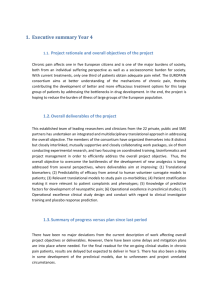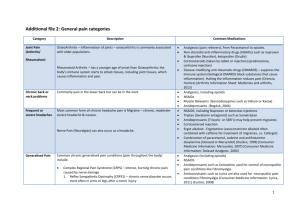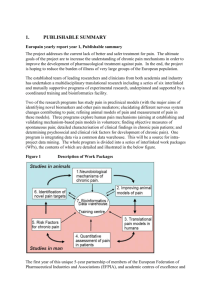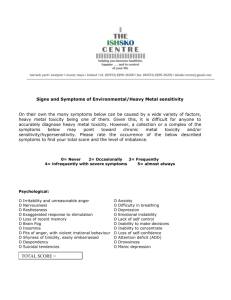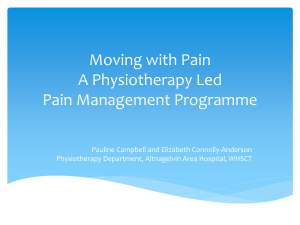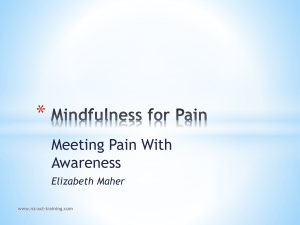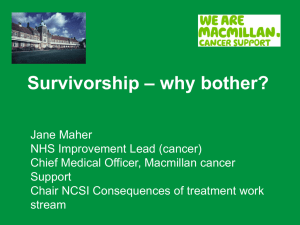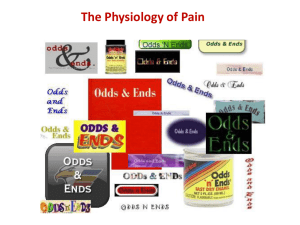Calmare Therapy for Chronic Pain Management
advertisement
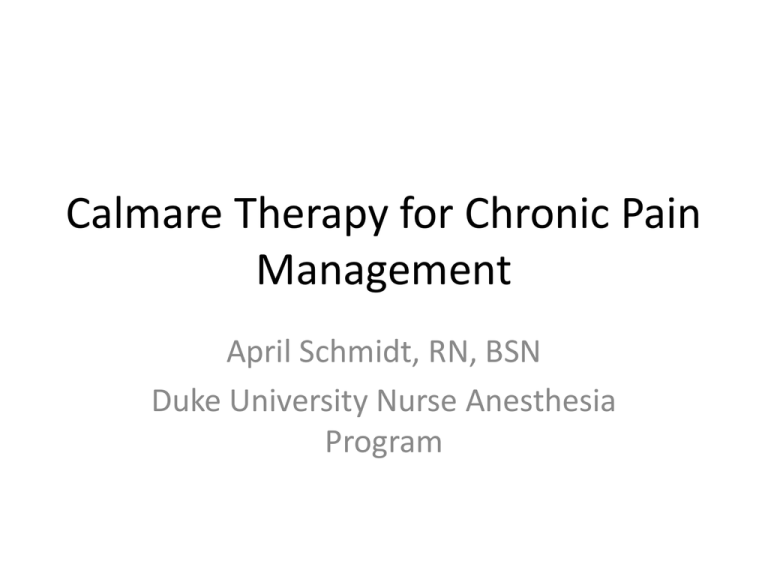
Calmare Therapy for Chronic Pain Management April Schmidt, RN, BSN Duke University Nurse Anesthesia Program Course Objectives 1. Participants will be able to define what Calmare therapy is and describe the mechanism by which it works. 2. Participants will be able to state 3 pain conditions that may be treated with Calmare. 3. Participants will be able to list 4 advantages of using Calmare therapy over traditional chronic pain management treatments. 4. Participants will be able to list 3 contraindications to Calmare therapy. The Problem: Chronic Pain • Widespread issue • Millions of Americans live with chronic pain everyday • Many are unable to perform ADLs or work • Many disability claims are due to chronic pain • Sleep and mood disturbances What does pain look like? What does pain free look like? Chronic Pain Review • C fibers: unmyelinated, smaller (diameter 0.41.2 µm) • Transmit second pain or slow pain • Burning, aching, throbbing pain • Major neurotransmitter is substance P which binds to neurokinin-1 receptors postsynaptic • Duration exceeds duration of stimulus Review Chronic Pain Pathway • Primary afferents-DRG • Dorsal Horn of SC • Ascend/Descend 1-3 segments in Tract of Lissauer • Primary afferents synapse with 2nd order neurons • Terminate in Rexed’s Laminae II and III then V via interneurons Chronic Pain Pathway con’t • Decasate and ascend in contralateral lateral spinothalamic tract to reach the thalamus • Synapse with 3rd order neurons to send message to cerebral cortex What is Calmare? • Calmare-Italian for “to soothe or ease” • Non-invasive nerve “scrambler” for treatment of drug-resistant chronic neuropathic and cancer pain. • FDA approved in 2009 • Used in Europe for several years prior Calmare How does Calmare work? • Device creates and sends a “no pain” signal which becomes the dominant signal received by the brain changing the patient’s perception of pain. • Biophysical rather than biochemical approach • Transdermal modulation of pain using 5 mA • Utilizes 5 different “channels” each with independent output intensity Inventor: Giuseppe Marineo • Researcher and bioengineer • Began research in 1983 • Also developed Entropy Variation System –treats chronic degenerative disease by regenerating tissue (cirrhosis) Treatment regimen • 10-12 consecutive treatments; one 30-45 min. treatment per day over a period of two weeks • During therapy, some patients report “0” pain. • Patients may experience significant pain reduction for an extended period of time (time length dependent upon underlying cause) • Booster cycles can be given when needed Conditions Treatable with Calmare • Chemotherapy-induced peripheral neuropathy • Intractable Cancer pain • Failed back surgery syndrome • Sciatic and lumbar pain • Post-herpatic neuralgia • Post-surgical pain • Brachial plexus injury pain • Low Back/neck pain • Chronic Neuropathic pain • Phantom limb pain • Reflex sympathetic dystrophy Advantages of Calmare • • • • • Non-invasive Painless procedure Immediate pain relief Ongoing pain control No adverse side effects of opioids Cost • • • • 10 sessions cost $1,500-2,000 Not covered by many insurances-why? CPT coding as of 1/2012 Since then more insurances are starting to cover Calmare Contraindications to Calmare • Pacemaker or AICD • Vena cava or aneurysm clips • Coronary/vascular stents • Pregnancy • Hx of epilepsy • Hx of brain damage • • • • • • Brain metastasis Anticonvulsant meds Hx of celiac plexus block Cardiac ischemia Severe arrhythmias Implanted nerve stimulators • Latex allergies Risks • Closure of airway: Stimulation over the neck (laryngeal and pharyngeal) due to muscle contractions may be strong enough to close the airway • Cardiac arrhythmias: Machine capable of delivering 25 micro coulombs so electrodes placed in a trans-thoracic position may cause cardiac arrhythmia Research: Ricci, Pirotti, Scarpi, Burgio, Maltoni, Sansoni, & Amadori, 2011 • Prospective, exploratory, non-controlled study • 73 adult pts (40 with cancer pain, 33 noncancer pain) all with pain > 5/10, Median age 66, males and females evenly divided • Purpose: To assess efficacy and tolerability of the device. • Numerical rating scale: 1-4=mild, 56=moderate, 7-10=severe Results: Ricci et al, 2011 8 7 6 5 Overall 4 Cancer pts 3 Non-cancer pts 2 1 0 Baseline pain After 5 txs After 10 txs 2 wk F/U Wk 4 F/U Results: Ricci et al., 2011 • Performance slightly greater in the non-cancer group (perhaps bc cancer group started with lower baseline pain) • At 1 mth after tx start, 81% of overall participants had responded (8% of them only partially)and 19% had not. • No side effects reported • 97% of pts said they would repeat this tx Testimonial • Camp Lejeune- pt with GSW to RUE-chronic neuropathic pain-unable to use RUE at all. • Treatments tried: surgery, opioids, non-opioid analgesics, brachial plexus blocks • After Calmare therapy, pt experienced significant reduction in pain • Able to return to work and hold his newborn baby! Where is Calmare available? • • • • • • • • • Arizona-2 California-3* Connecticut-2 Florida-3* Illinois-1 Maryland-2* Montana-1 New Jersey-1 New York-3 • • • • • • • • • North Carolina-1 * Oklahoma-1 Rhode Island-1 Texas-1 Utah-3 Virginia-3* Washington-1* Wisconsin-1 Wyoming-1 Further Research Needed • • • • Need RCTs Need larger studies Need studies on children Need long-term studies: -How long does the pain relief last? -Number of treatments needed to maintain pain relief? -Any side effects long-term? Further Research • Mayo Clinic: currently conducting RCTs on Calmare for tx of Shingles and Chemo-induced peripheral neuropathy (CIPN) • University of Wisconsin: RCTs on Calmare for CIPN • Virginia Commonwealth University: RCTs for Chronic pain and numbness associated with CIPN. Questions??? References • Calmarett.com • Morgan, G. E., Mikhail, M.S., & Murray, M.J., (2006). Clinical anesthesiology (4th ed.). New York, NY: McGraw-Hill. • Ricci, M., Pirotti, S., Scarpi, E., Burgio, M., Maltoni, M., Sansoni, E., & Amadori, D. (2012). Managing chronic pain: Results from an open-label study using MC5-A Calmare device, Support Cancer Care, 20:405412. doi:10.1007/s00520-011-1128-6

